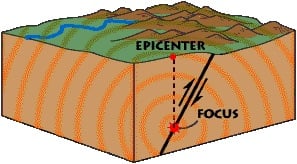Most faults in the Earth’s crust don’t move for a long time. But in some cases, the rock on either side of a fault slowly deforms over time due to tectonic forces. Earthquakes are usually caused when underground rock suddenly breaks and there is rapid motion along a fault. This sudden release of energy causes the seismic waves that make the ground shake. During and after the earthquake, the plates or blocks of rock start moving—and they continue to move until they get stuck again. The spot underground where the rock first breaks is called the focus, or hypocenter of the earthquake. The place right above the focus (at the ground surface) is called the epicenter of the earthquake.

Try this little experiment:
- Break a block of foam rubber in half.
- Put the pieces on a smooth table.
- Put the rough edges of the foam rubber pieces together.
- While pushing the two pieces together lightly, push one piece away from you along the table top while pulling the other piece toward you. See how they stick?
- Keep pushing and pulling smoothly.
Soon a little bit of foam rubber along the crack (the fault) will break and the two pieces will suddenly slip past each other. That sudden breaking of the foam rubber is the earthquake. That's what happens along a strike-slip fault.
Seismic waves can also be caused by natural processes other than earthquakes and by human activities. Some are geological like the Menominee Crack. When magma moves toward the surface prior to volcanic eruptions, it produces seismic waves that can be used to forecast an eruption. Ocean and lake wave activity, mining operations, subway construction, and other underground explosions can cause seismic waves, too. Nuclear warhead explosions create seismic waves very much like large earthquakes—one of the reasons for the global nuclear test ban is that no nuclear warhead can be detonated on Earth without producing seismic waves.